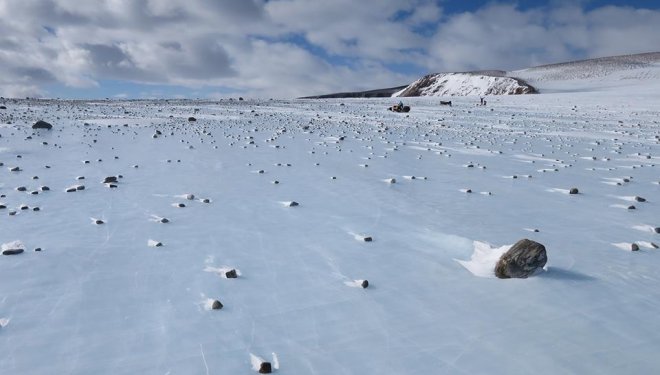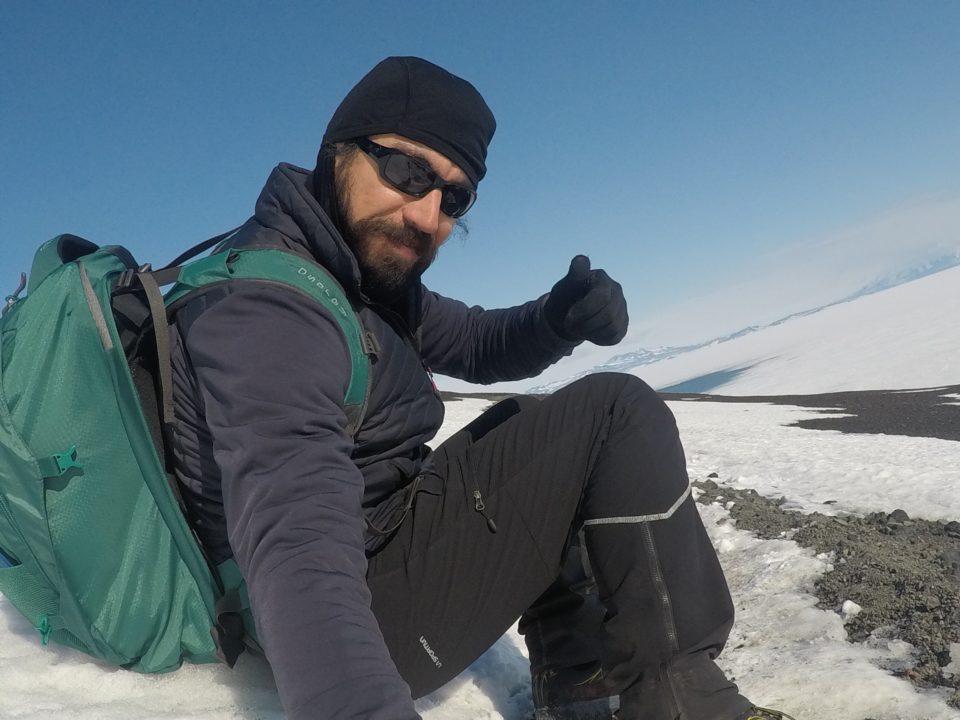
A Greek Geologist in Antartica
Geologist Ioannis Baziotis is the assistant professor at the Agricultural University of Athens, who, along with other scientists, discovered and collected 263 meteorites in the coldest, driest, most unspoiled and beautiful part of the planet. He was the first Greek scientist to be selected and the one who traveled with a NASA mission to Antarctica. Plus, recently, he had been the head of a group of scientists who spotted significant minerals on the Château-Renard meteorite for the first time with, the so-called “high-pressure polymorphs.”
He was born in Athens, in 1980 and graduated from the Department of Geology of the University of Athens in 2002 and received his Ph.D. from the School of Mining and Metallurgical Engineering of the NTUA in 2008 – a year that he also received the Ktena Prize from the Academy of Athens. In 2013, for one year, he was a postdoctoral researcher at the University of Perugia, the Aristotle University of Thessaloniki and the University of Vienna, and in 2016 he was a researcher for postdoctoral research in NASA. Since then, he has been an assistant professor of mineralogy and petrology at the Agricultural University of Athens at the Department of Natural Resources and Agricultural Engineering.
NASA seeks traces of planet Mars, the Moon, of asteroids, the creation of our solar system, the possible existence of life in a non-terrestrial environment through this capability of studying the basic building blocks which made up our solar system (stones coming from different areas) and the processes required to create and develop it.
For this reason, since 1976 the Space Exploration Alliance has established the Antarctic Search for Meteorites (ANSMET) missions for finding meteors – missions which have discovered more than 22,000 meteorites so far. The Greek Professor of Agriculture participated in the 41st NASA mission in November 2017.
Speaking to the Athenian and Macedonian News Agency, he said he wanted to “borrow” some meteorites and bring them to Greece to study them with his students at the University of Athens. He also wants to create the first Global Planetary Society in Greece and informs us that only one meteorite, of the approximately 67,000 globally recorded, comes from Greece and is the meteorite Seres, a chondrite who fell in the area of Serres
Thus, NASA’s mission has managed to recover 263 meteorites from the Antarctic blue ice fields.
Their study helps scientists understand how our solar system originally formed and how it evolved. The meteorites come from a multitude of celestial bodies, such as the satellites, the Moon, the planets (such as Mars), and asteroids (such as Hestia). Ioannis Baziotis explains that their study reveals the meteorites’ “secrets”, such as their age and processes of formation, while they were in their maternal body of origin.
Still, many meteorites give information about the temperature and pressure that developed during the impact of the asteroids on the parent body. So, an important field of research is the understanding of the critical role played by water in the early stages of our solar system’s development. Where the water came from or why our planet is habitable, are questions that ultimately relate to the issue of the development of life.
At the same time, the geologist says that the continent is the richest meteorite vault. It is the area where more than 40% of all meteorites found on Earth have been recovered, as it occupies a very large area of the Earth, and is desolate and cold. The meteorites that have fallen on ice for hundreds of thousands or millions of years come to light as the ice is removed due to a complex process of conversion from solid to gas without the liquid and wind action.
A critical role is played by the meteoric contamination by the Earth’s footprint. For example, if a meteorite was in an area with intense rainfall, many of its features, both externally and those associated with its chemical composition, would have been altered. In Antarctica, however, due to the absence of water in fluid form, meteorites keep intact the precious chemicals and not just their elements. That is why the time of their collection took two to three minutes each.
When asked about the Antarctic environmental conditions, he replied that it was really difficult. The average temperature they faced in the countryside was minus 25 degrees, however, with the presence of wind, it felt much lower. There were days when the wind was vibrating more than ten Beaufort at a speed of about 95 kilometers per hour, giving the feeling of cold at the temperature of minus 45 degrees.
Under these intense air conditions, the Scott tents constituted for them a life support system. They had a small propane kitchen, which, when in the tent, was continuously lit and helped maintain the temperature within the tent at acceptable levels and melt the ice or cook.
“Scott tents are capable of withstanding wind speeds of 200 km/h, so much faster than those we experienced. In fact, the danger that we experienced in the tent because of the wind was not great. But, cooking in there, the greatest fear – and in the opinion of John Schutt’s who’s the most experienced in the Antarctic – was the fire. It is something we knew and of course, we were, as far as possible, careful.
You have to be careful when you live, cook, work, sleep beside the flame, with the propane bottle standing in the middle of the double wall of the tent. Because of the flame from the burning propane, a problem that could have been even fatal to our lives was carbon monoxide. The colorless, tasteless, poisonous gas that can make you “sleep” without realizing it. In my opinion, the greatest danger was not cold or wind, but fire and carbon monoxide,” he said.
He admits that the natural beauty, especially in the Amundsen Glacier area, at the altitude of 2,200 meters, with the surrounding mountains and their peaks reaching 3,700 meters, was unique. He thinks the most dangerous part of the mission was probably driving snowmobiles over the big blue ice cracks, which often exceeded the depth of 15-20 meters. The rule was that if they were going over such cracks, their width had to be less than half the length of the snowmobile. Otherwise, they would have to bypass them, following another route.
While in the event of intense cloudiness in the sky, there was no possibility of distinguishing of the surface, because it was often covered by snow. So the sky and the surface looked like one, and that was one of the reasons many times they stayed in the tent.
While sharing some images, he said “Something that kind of shocked me is the absence of any sound from the atmosphere when it was not windy. Perhaps Antarctica’s “deep field” is the only place on our planet that you can hear the sound of silence. It is a unique sensation that can hardly be described with words. A state that when combined with the incredibly beautiful image of the Antarctic mountains, you really feel blessed that you exist and are healthy in this unique part of our solar system, the Earth. ”
As far as cohabitation with the other scientists in the mission is concerned, he says he was in the same tent as the climber and team leader, the much-experienced-in-Antartica, John Schutt, fact the Professor considered a tremendous honor and opportunity for him. “Being for five weeks on the same tent as the man who has participated in 37 consecutive ANSMET missions was amazing. The collaboration with him, as well as with the other scientists, was excellent.
We all had a common purpose. There was no concept of the individual, but of achieving the goals of the mission through the group. From the beginning, the association with the other three members was excellent, and as the time living together went by, we became bonded more and more, becoming a family” according to his words.
The Geologist at the University of Athens is also writing a book and has almost completed the manuscript text on his experience in Antarctica. The aim is to inspire young people, to show them that they are worth dreaming even in our “troubled country. The human resources of Greece, starting from the very early age, are of exceptional quality. With hard work, loyalty, and goal-setting, one can achieve something that feels unrealistic or even very modest. ”
He is currently working with other academics to set up the Planetary Society, which aims to have space research, and he has set his mind to bringing to Greece the meteorite Seres, the only confirmed meteorite that has fallen on Greek soil. He lectures, researches, teaches, and so on.
























